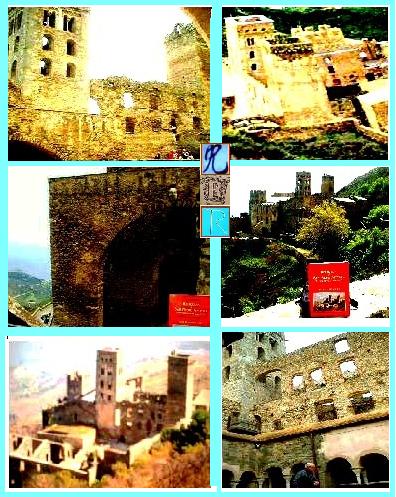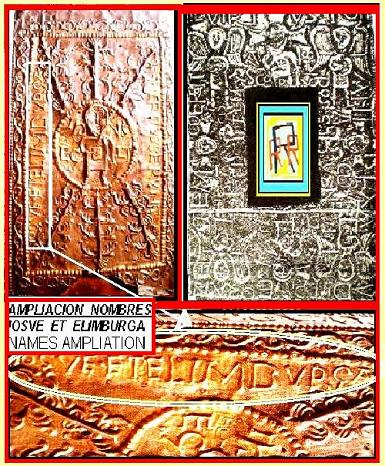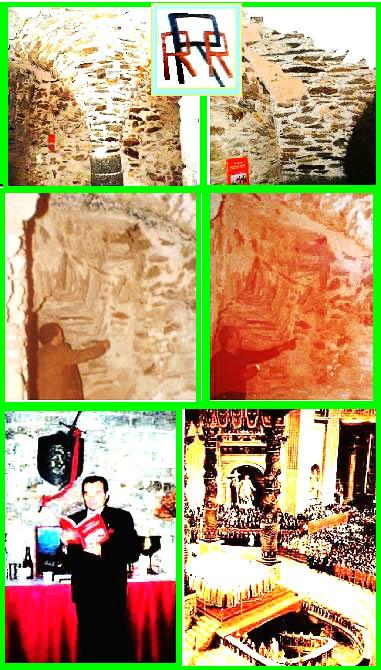

ENLACES GENERALS LINKS:http://www.oocities.org/es/ramonet_riu/links2009.html
ALTERNATIVE:http://www.oocities.org/es/ramonetriu/links2008
|
RELIQUIES DE L'APOSTOL PERE
|
ATÉS QUE L'ANY 2006 ES VAREN EXPOSAR AL VATICÀ MATERIALS PROCEDENTS DE LA DESCOBERTA DE LA TOMBA DE SANT PERE APOSTOL,
I PER ALTRA BANDA, AL MUSEU MARÈS DE BARCELONA S'EXPOSARENEN MATERIALS I LLIBRES REFERENTS AL MONESTIR ON FINALMENT VAN SER AMAGADES BONA PARTE DE LES PRINCIPALS RELÍQUIES DE LA CRISTIANITAT, M'AGRADA -SENSE RENCÚRIES- QUE TANT UNA COM L'ALTRA FOSSIN MOLT VISITADES, MALGRAT QUE EN CAP D'ELLES S'HI FEU ESMENT DEL MEU LLIBRE (Editat l' any 1990), EN EL QUAL JO DEFENSO QUE: DECEBUT, CONTINUARÉ EN ANGLÉS I EN CASTELLÁ.
SON LES RELÍQUIES DE SANT PERE APÓSTOL DE JESUCRIST.
POSTERIORMENT NO S'HA SUPERAT ALLÒ QUE JO VAIG HUMILDMENT PRESENTAR TAN BON PUNT HO VAIG DESCOBRIR.
The few relics that Pope Gregorius I believed were of the Apostle St. Peter, he moved them away from the Vatican by sea in the year 610, in order to safeguard them from a feared invasión.
The relics were finally deposited in a cave in Ampurdan, a region of Girona - NE of Spain- where some years later the church of the very great monastery "SANT PERE DE RODA"was build.
The relics were discovered in the year 1910, when the ground near the main altar of the so rundown church sank under the feet of some thieves who were stealing marble.
Without knowing what bones were contained in this "briefcase-relicary",it was finally put in the attic of the "MUSEU D´ART" in Girona, during the long restoration of which I identified them as all being part of the same lot, in spite of them being separated. Later, the relics and relicary went on show inside a glass case in the first room of the Museum.(BELLOW: It's indicated by the arrow
Inside of the suitcase there ara a portable altar very decorated with very misterious inscriptions
The voluminous DIZIONARIO DE LE ABREVIETURE LATINE E ITALIANE (Milano 1187) show that letter G was written like Ç, in Elimburga name, that it includes the small altar of San Pere de Roda. (Emporda North of the Costa Brava de Girona). So, "Ç" was its normal design in the VII century (and one stayed until century X).
Of the same period it is pompous letter "M" of Elimburga, with design of conventional heart. Throughout century V was written like our present very small letter "m" minuscul, but soon the inner outline of letter "M" was made descend until the base of other arcs from this letter.
The metallic cross that also includes the same lot of Saint Peter relics, still is more conclusive to date the lot discovered buried to the times of the Pontiff Gregorio I. They called it a "encolpium", and became from second half of the X century til to beginnings of the VII. (There is another metallic box of relics with similar desings in the Treasure of the Doumo de Monza in Italy).

THE OLD "SANT PERE DE RODA" OUTSIDE LANDSCAPE, EXEPT THE CLOISTER BELOW RIGTH.
THE ANCIENT CRYPT was opened to the few visitors to such a remote place in Catalonia, only 10 years before my investigation (1976). The church of the big monastery was build over the crypt. The monks, knew that there were relics of St. Peter, but never knew exactly where they were.
The reliquary has been hidden in the wall of the cave (similar to its hiding place in the Vatican in the year 610).
The committee then left many other relics in the ground as a "decoy" ".
The person with the raised arm, indicates the exact place in the wall of the cave where they had hidden the relicary (his location later forgoten). So, 12 centuries later, exactly in the year 1910, the relics where finally discovered.
I found out about them when I read a forgotten Ecclesiastic Yearbook from the year 1917, astonishing me that I never knew about it before.
My phonecall to the parish priest of that church, confirmed me -there and then- that all this was forgotten, because he had been there in charge for the last 25 years and he said to me: ""I could not belive that nothing was ever published"".

Gregorius I build the "Confession",which is a very reduced space, exactly undernearth the main altar of Saint Peter of Vatican.
There Gregorius I celebrated a service on the Tomb which was covered with the apron of silk tissue, that was then used to wrap the relicary (as is mandatory in the liturgy).
He hid the "briefcase" in an marble hole inside the wall, closing it with another piece of marble. The silk tissue helps preserve it from deterioration.
IN MY BOOK I ALSO INCLUDED THE DECIPHERED SYMBOLS
that Pope Gregorius I engraved on the bones not in the "briefcase- relicary,", which were cleverly restored in 1910 . In the "British Museum" they informed me that nothing similar for the Medieval period exists.
The excesSive secrecy of Gregorius I, dictated strange ways of refering to the saint´s relics, but it Is most important that the measurement of the hideout place "Confession", and the "briefcase" (icluding its lost cover) coincide.
The official investigation under Pope Pius XII concluded that: "the "Trophy" that distinguished the "St. Peter´s Tomb", was found, but not the relics.
Tradition says that the relics of the Apostle Peter were transferred(610) with great pomp, but nothing is mentioned about bells ringing to celebrate their return to the Vatican.
THE RELICARY ALSO INCLUDED a portable altar used by Pope Pelagius II . It was a present from the mysteriuos IOSEPH and ELIMBURGA."
This altar traveled with the St. Peter´s relics inside the briefcase, and in the oposite side there is a slate stone which incrusted in the centre and symbolise St. Peter (In the spanish language this page is the same, but with the title "/APOSTOL.html)

AND THE SUITCASE INCLUDING A LOT OF BOX'S RELIC, ALSO INCLUDED A SMALL ALTAR.
The next information I supose that will be very interesting for the descendents today of Order of Temple, the Masonery one, or several other like P.S.. Pay attention please:
The merovingios managed to save the inheriting boy Sigebertus, after assassinating king Clodoveus, hiding it in Renes-le-Chateau (suth of Fr.), where -by the way- never it was the treasure, but only the tracks that guided the priest Berenguer Sauniere and my. I exposed it in my still unpublished work written in 1.980; it was in the cloister of a cisterciense monastery in Var departament (Fr.).
Since first of all I want to see evolve the so exciting subject of study, and since I feel so impotent as those that investigates the order of the Priorat de Sion (of which it pleases to say to me that his last Great Maester universal was my countryman Arnau de Torroja (1.180-1.184), I am finally decided to expose it here, advising interested the following one via:
Perhaps the carolingian kings they did not manage to destroy all the information of the merovingial ones, to which they happened in the power, and so, like by birth, I could know the templer Arnau de Torroja, mentioned far better that even the great spanish "Espasa Encyclopaedia" where it does not consist, the same it can occur in somebody native one of the French Burgundy with respect to Elimburga, at least!.

The question would be try to identify two descendants of Maria Magdalena, that is, of the family of king David, due the attention that gave to bonth names the Pope Gregorius I Magnus,...who something had to know about the "P.S" order.
In this portatil altar (which I travel within the "briefcase") a stone inlaid rectangular slate in the center symbolizes saint Peter apostle. The voluminous DIZIONARIO DI ABREVIETURE LATINE E ITALIANE (Milan 1187) show that letter G was written like Ç of the Elimburga name, that includes the portatil altar of San Pere de Roda (NE of Catalonia Costa Brava, Gi.). So it was its normal design in century VII. (and one stayed until century X).
Of the same period it is pompous letter M, of Elimburga, with design of conventional heart.
Throughout century V was written like our present letter "m" small letter, but soon the inner outline of the letter was made descend until the base of the own arcs.
The metallic cross that includes the same lot of relicarios, still he is more conclusive to date the lot discovered buried to the times of the Pope Gregorio I. They called it "encolpium", and so they became from second half of the century to beginnings of the VII. There is another metallic box of relics with similar desings in the Treasure of the Doumo de Monza (Italy).

THE PRESENTATION OF MY BOOK. Inside I included the official investigation of the crypt of the "Confession" under the main Altar of ""Saint Peter in the Vatican""
The book was edited in the year 1978, and at the front of the book the cardinal of Barcelona Mns. Narcis Jubany wrote:"
VERY INTERESTING AND WORTHY OF THE BEST ATTENTION".
Nevertheless, my work remain without success. At last, he not did agree with the archaeologist at the said monastery, who thought I was an intruder whom he found agravating. For my discharge, I also reviewed the Vatican crypt´s "Confession", the circumstances and conduct of several Popes from that century, the "Portable-Altar"´s graphology (which travelled inside the "briefcase-relicary") etc., thues compsating for not official graduaton.
Beforehand, I had also read everyone of its books whatever with avidity of the set assembly in ruins, of which I will stand out that: Following the three years of my investigation, a great quantity of treasures was discovered, including a pitcher of jar full of gold´s coins.
I am between the adventurous finders of antiques who many years ago they risk all kind of dangers in exotic lands (or the man who were serching temples or looking for one tribe), and the present archeologist of rigid norms, in whose financed missions they behave as in front of a musical score, because in spite of being licensed, the team research has everything previously sounded the place and is work is like inside an orquesta where everything was codified, tematized, etc.; so that they do not have margin for the risk,... and the less for own imagination. But I am thankful to them, because is its pretty 3D virtualizations. The archeologist, of course they are able to see my defects, but not his.

TRADUCCION AL CASTELLANO
Venerar las reliquias y poder deambular ordenadamente a su alrededor, en el
siglo XII justificaba la construcción de un templo romànico. El
primer lugar donde se realizó esta experiencia en Cataluña fue
en el monumental monasterio de San Pedro de Roda (Costa Brava - NE. de España),
el mismo donde defiendo que se guardaron las reliquias de san Pedro apóstol
el año 610. Se erigió con el poder de la fe, siendo la razón
lo que evita que se desplome.
Cuanto quede de las primeras relíquias de la cristiandad, está en Cataluña, porque los restos que no se encuentren tirados por las pendientes del Valle de la Santa Creu en la sierra Verdera (es largo de explicar, pero lo sinteticé en mi libro), está en el Museu d'Art de Girona. En mi libro sobre la investigación del hallazgo de las únicas reliquias de san PEDRO APÓSTOL, accidentalmente realizado por unos ladrones de mármoles del altar mayor de la gran iglesia del monasterio de Sant Pere de Roda (obra autoeditada el año 1.987), desde la primera página hice constar la opinóión que mereció al entonces cardenal de Barcelona Mns. Narcís Jubany, cuando se la presenté personalmente en 1.976: MUY INTERESANTE Y DIGNO DE LA MEJOR ATENCION.
PRESENTÉ MI LIBRO INCLUYENDO LA INVESTIGACION OFICIAL DEL VATICANO TITULADA "ESPLORACIONI", QUE EXCAVÓ "LA CONFESION" DEL VATICANO, SE TRATA DE UN GRANDIOSO LIBRO DE EDICION MUY LIMITADA, EL CUAL, GRACIAS A MI DICHA RECOPILACIÓN, TAN INTERESANTE TRABAJO SE RECORDARÁ A NIVEL POPULAR.
No obstante mi contribucióón quedó diluida. Al menos el entonces cardenal de Barcelona Narcís. Junany no opinó tan evasivamente como los arqueólógos que excavaron el dicho monasterio, para quienes yo era un intruso al que odiar,...y vaya si me odian!. En mi descargo cuenta que también repasé la excavación oficial del subsuelo justo debajo del altar mayor de San Pedro del Vaticano, las circunstancias y conductas de todos los Papas implicados; asi como haber estudiado concienzudamente la grafología del "Ara portatil" que viajó dentro del "maletín-relicario", etc., compensando con mucho esfuerzo el carecer de determinado título especializado. Hay que recordar que el dicho cardenal de Barcelona, hace décadas fallecido, por aquel entonces pudo haber sido Papa de Roma,... es decir, que realmente se "mojó" mucho al comunicarme dias después su opinión por escrito. Yo soy vocacionalmente investigador de cuanto ignoro, o de aquello que humanísticamente me sorprenda. Dicho sea también, que soy una persona religiosa en un termino medio como cualquier lector de estas líneas, aunque por el tema que presento lo pueda parecer. En las páginas de un viejo volumen titulado "Anuario Eclesiático de la Iglesia Española del año 1.917", se incluyí un artículo con muchas fotos, al leer el cual me llevé la mayor sorpresa. Me tengo por una persona culturalmente muy bien informada (y al escribir cultura, quiero decir de élite), y para mi ego resultó imperdonable ignorar nada menos que un tesoro artístico encontrado en las ruinas del emblemático gran monasterio catalán de Sant Pere de Roda (en el cabo de Creus -Gerona), por más que hace muchos décadas esté abandonado a su suerte. Dicho lote de relicarios diminutos y una ara portatil muy artística en 1.917 había sido pues, presentado a la erudici;oacute;n eclesiística por un ilustre sacerdote llamado Mn. Gudiol Cunill, comisionado por su obispo para estudiar el tal hallazgo en la entonces tan inaccesible costa norte de aquella comarca. El voluminoso DIZIONARIO DI ABREVIETURE LATINE ITALIANE (Milán 1187) la
letra G se escribía como la Ç del nombre Elimburga que, junto al de José, se incluye el
ara portatil de San Pere de Roda. Tal fue su diseño normal en el siglo
VII. (y se mantuvo hasta el siglo X).
Del mismo periodo es la ampulosa letra M del nombre de la misteriosa donante Elimburga, con diseño de
corazón convencional. Durante todo el siglo V se escribió como
nuestra actual letra eme minúscula, pero luego el trazo interior de la
M se hizo descender hasta la base de los demás arcos de dicha letra.
La cruz metálica que incluye el mismo lote de relicarios, aún
es más concluyente para fechar el lote descubierto enterrado a los tiempos
del pontífice Gregorio I. La llamaron "encolpium" y se hicieron
asi desde la segunda mitad del siglo VI hasta inicios del VII. Hay otro relicario
metálico con repujados semejantes en el Tesoro del Doumo de Monza (Italia).

MONASTERIO DE "SANT PERE DE RODA" Hoy resulta obvio que, a pesar de su gran erudición, Mn. Gudiol ignoraba los escritos del antiguo cronista de aquella zona de Cataluña llamado Jeroni Pujades. Éste, por ser el padre del monje superior de aquella prestigiosa comunidad, tuvo acceso a los antiguos escritos que informaban de un lote de relicarios escondido en alguna parte ignorada del dicho monasterio por cierto en las más recónditas costas del cabo de Creus en Gerona.
LOTE: MALETÍN-RELICARIO: En mi libro, incluí también el descifrado de los símbolos que el papa Gregorio I grabó sobre los huesos del exterior de la "arqueta-relicario", la cual en 1.910 fue muy ingénuamente restaurada.

Los merovingios lograron salvar al niño heredero Sigeberto, después
de asesinar al rey Clodoveo, escondiéndolo en Renes-le-Chateau (donde por
cierto nunca estuvo el tesoro pero si las pistas que guiaron al párroco
Berenguer Sauniere y a mi. Lo expuse en mi obra aún inédita escrita
en 1.980; estuvo emparedado a la sombra de dos cipreses en el claustro de un monasterio
cisterciense del departamento de Var, Fr.)
Puesto que ante todo yo quiero ver evolucionar el tan apasionante tema de estudio,
y dado que me siento tan impotente como los que indagan la orden del Priorato
de Sion (del cual me complace decir que su último Gran Maestro universal
fue mi paisano Arnau de Torroja (1.180-1.184), me decido por fin a exponerlo aquí,
aconsejando a los interesados la siguiente vía:
Quizá los carolingios no lograsen destruir toda la información de
los merovingios a los que sucedieron en el poder, y así como yo por nacimiento
pude saber acerca del Maeste Templario Arnau de Torroja (al cual ignora la Gran
Enciclopedia Espasa) lo mismo puede suceder, en lo referente a Elimburga, a otros investigadores, ... al menos los oriundo de la Borgoña francesa.

Cuando investigué hace décadas el viejo monasterio de San Pedro de Roda tan sólo haccí diez años que la cripta debajo del altar mayor de Sant Pere de Roda, en el Ampurdán (Gerona) siempre antes estuvo tapiada, y por fin había vuelto a hacerse accesible para los visitantes de aquellas ruinas.
AGUJERO EN ZONA DEL HALLAZGO JUNTO AL ALTAR MAYOR: En el grupo de fotos inferior, la de la abajo a la derecha, muestra el lugar entre el altar mayor y el muro alrededor delimitando aquel lugar, según lo he ido viendo cambiado a lo largo den tiempo en mis sucesivos viajes. En principio, la persona fotografiada llegaba a hundirse en el agujero del hallazgo casi por completo. Posteriormente lo encontré medio cubierto, y en fecha reciente se ha nivelado el suelo con la base de las columnas, siendo tal como debíEde estar antes de robarse los mármoles que decoraban las piedras.


Aquesta web també s'obra escrivint al final: rex_mundi, o be /rexdeus

Hay explicaciones de cada diapositiva: Clicando en NOTAS DE ORADOR
(Ruta: Abrir el cuadrado de mandos -junto al lápiz del lado inferior izquierdo de la pantalla-, y clicar primero "Pantalla").